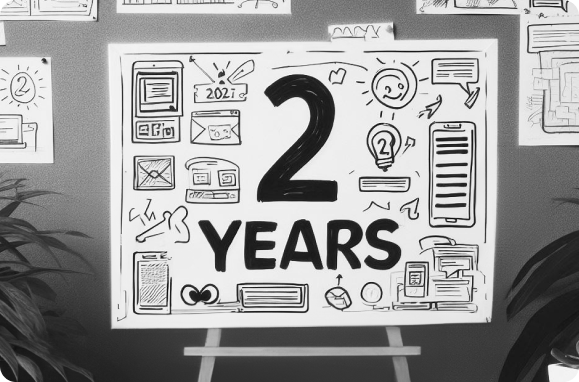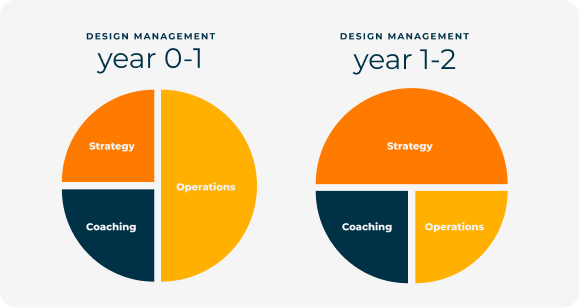Design Management – Year Two

My second year of design leadership has been much different than I could have anticipated, and I’ve been hyping myself up about what I’d write about for a while now. I’ll share some of my experiences this past year, and I’m hopeful there are a few learnings for people to take away by hearing how I’ve tried to navigate being a leader during times of change. So here we go! Design management, year two.
We’re not in Kansas anymore…
It’s not all that uncommon in tech for change to swoop you up and unexpectedly transport you to a new, unfamiliar world. I’ve experienced similar periods of time at every tech job I’ve worked at, and my current job has been no exception.

This past year our UX team has been going through a lot of growth, but also a lot of growing pains. To put it simply, we’re trying to level up our maturity and increase our impact in our organization in a big way.
In a short time, we’ve standardized a lot of processes and changed how we operate in our company. Instead of leaning on the understanding of others, we’re gaining understanding for ourselves. Instead of following, we’re working to become leaders. Instead of acquiescing, we’re advocating and being more direct. I don’t think anyone would disagree that those are noble goals, but practicing them consistently and creating processes around them while simultaneously leading your teams through them is no small feat.
It’s important to stay hopeful that the yellow brick road will lead to a positive outcome, but knowing the journey ahead and challenges yet to work through also highlights the need for resilience through uncertainty.
Evolving responsibilities
In my first year of management, operational activities took the most time and coaching and strategy were split. As our business has grown, the responsibilities and the needs of my role have also grown.
Today, a large majority of my time has needed to be devoted to strategy and guiding the product work through collaboration with my team and stakeholders.

This goes to show that there are a lot of factors that can make your role shift dramatically in leadership. Organizational growth and change which I’ve already talked about, but also the stage of growth the business is in, competitive landscape, budget and resource constraints, company goals, team size, team goals and many other factors impact how you need to operate. The leader you needed to be last year may not be the same leader you need to be today.
The leader you needed to be last year may not be the same leader you need to be today.
This goes the same for the design ICs out there. Your responsibilities can shift in ways that support your strengths or vice versa, creating opportunities for growth or potential struggle. Moments like these can make for watershed moments where you need to be introspective about who you are and what your want out of your career.
People, people and people
People are at the core of everything you do as a manager. A lot of the videos I watched and articles I read early on around UX Management mentioned how much time you’ll spend in meetings. Yeah, that’s true, but meetings are just the channel in which you operate. People are the way you accomplish your goals. You influence people, you empower people, you defend people, you motivate people… the list goes on.
As a manager of designers…
You have to be the advocate, the rock, the person on the front lines. The unashamed, fearless and empathetic person who can be trusted. There is no spectator sport when you’re leading people. Regardless of how hard certain aspects of your job are, you have to rise above, and it really does push you–Especially if you’re an introverted person!
As a partner to product owners…
You have to be comfortable being direct. You are the last line of defense of a good UX process for your team. If you don’t stand up for it, no one else will. You have to be comfortable saying no, and you have to back up the reasons behind your strongly held opinions.
As as leader who reports to other leaders…
You have to model the behavior you ask of your team with your leader. The higher you go, the more it requires that you’ve done your due diligence to bring clear and actionable problems that they can help resolve. It’s a little cliché, but it really is better to ask for forgiveness than permission. And it’s better to try and solve your problems on your own before involving others. If I had one call to action for design managers, I’d say stop being hesitant about taking initiative. Get in the mindset of doing rather than asking, which is something I’m still working on today.
Leading diverse teams
In the past couple years, I’ve managed a lot of designers at various stages of their careers. My first team was mostly senior level+ designers, the second and third teams I managed were a mix.
Designers earlier in their careers require a hands-on approach, involving mentorship, guidance, and constructive feedback to help them develop their skills and confidence. On the other hand, seasoned designers may thrive with more autonomy and room for creativity. Knowing when to lean out becomes essential in empowering them to take ownership of their projects.
There is a caveat I learned, though. Just because a designer says things are good, or that they don’t need support, it’s still important to be intentional and dig into the specific challenges they are working through. There are many things that you as a manager will be more capable at resolving for them. Remember that just because a designer is resilient or experienced enough to work through their own challenges, it doesn’t mean they should always have to.
Just because a designer is resilient or experienced enough to work through their own challenges, doesn’t mean they should always have to.
Look for real opportunities to help your team be more efficient, and don’t just give lip service. Be honest with yourself, be assertive and push yourself to be a little more uncomfortable than you’re used to. Sometimes your situation will force you to be uncomfortable, but sometimes it won’t. If you’re not pushing at all, it can lead to complacency. In all this, remember to be mindful and understand your limits. Rome wasn’t built in a day.
Design perfectionism
I’ve come to wonder if we have a perfectionist epidemic in design. I’ve worked with so many designers in my career that are professionals at seeing the good in others, but never the good in themselves. I’ve been that designer myself a fair few times.
Unsurprisingly, those feelings can follow you right over to leadership. Doubting your impact, wondering if there is more you can do, or if you could be operating at a higher level than you currently are. It’s a natural response when more is required of us to push our practice and teams forward.
Perfectionism can lead to anxiety and constant second guessing of yourself. It can also cause you to want to isolate. It’s not a healthy place to be, so it’s crucial to recognize these tendencies and actively work towards cultivating a more balanced and self-compassionate mindset.
As you continue to work in design, I’d recommend that you reflect on where and how you want to grow. Continue grinding and getting better, but also evaluate how you’re leveraging your strengths.
Final thoughts and takeaways
When you experience change as an IC, it feels a little more binary because you don’t have as much choice. When you go through it as a leader, you still might not have much choice, but you’re also a conduit and representative of that change and vision to your team. I’ve really grown as a person and leader in this past year. This next year, I’m going to continue to work to increase my skills while also being an authentic leader and person.
Here are some additional takeaways that may be helpful to think about if you’re currently managing or just getting into design management for the first time in your career:
- Don’t forget your design chops. Take your manager hat off and bring your IC perspectives to your daily work.
- Take action; don’t wait. Initiative isn’t easy for everyone, but strive to be the problem solver. Initiate tasks—schedule meetings, brainstorm, follow up, provide feedback…
- Tracking your accomplishments as a manager isn’t as easy or tangible as it is as an IC. Make sure you find time to reflect on your impact and growth over time.
- You will likely miss doing design work at some point, but you’ll also find other fulfilling things in leadership that you would miss if you were an Individual Contributor.
- You may sometimes feel like you’re far from being the leader you think you should be, but remember that you’re much farther from being the leader you shouldn’t be.
- Keep yourself engaged in your craft and best practices in the industry. It will help you stay sharp as a manager. Even a few years managing away from IC work can feel like twice as long with how fast technology changes.
- Prioritize psychological safety within your team. Stress kills creativity.
- Be present, and listen to your intuition.
- Don’t worry about little things. Most things will get easier with time even if they don’t come naturally right away.
- Be yourself, and try to have fun!


